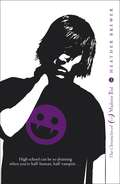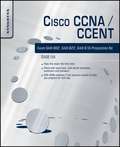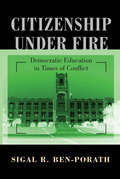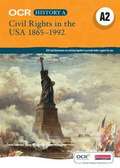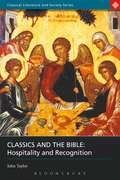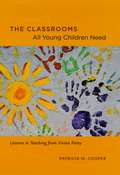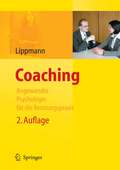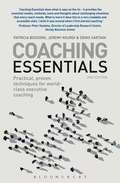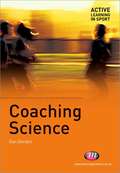- Table View
- List View
The Chronicles of Vladimir Tod: Tenth Grade Bleeds (The\chronicles Of Vladimir Tod Ser. #03)
by Heather BrewerIt's another dark year at Bathory High for Vladimir Tod . . .The evil vampire D'Ablo is hunting for the ritual that could steal Vlad's powers. His best friend doesn't want to be his drudge anymoreand it's getting harder for Vlad to resist feeding on those around him. But when D'Ablo shows up demanding his father's journal, Vlad realizes that having a normal high school year is the least of his concerns. Vlad needs to act fast, and even his status as the Pravus won't save him this time . . .
Cisco CCNA/CCENT Exam 640-802, 640-822, 640-816 Preparation Kit
by Dale LiuThree exams, two certifications, one complete Cisco training solution for networking professionals! The CCNA exam is an entry-level IT certification from Cisco Systems for professionals installing and maintaining route and switched networks. The current exam material covers networking concepts along with new and updated content on network security fundamentals and the basics of wireless networking. This book can be used as a study guide for either track you choose to receive your CCNA – the single exam, 640-802 or the combined 640-822 and 640-816, and for the CCENT certification which a student will receive upon completion of the 640-822 exam. The author team has arranged the content so that you can easily identify the objectives for each half of the combined exam. * Layout of the guide parallels the CCNA/CCENT exam objectives for ease of study * Details all aspects of the exams including security and wireless networking essentials * Covers everything from introductory to advanced topics—keeping the beginner and intermediate IT professional in mind * Chapter ending questions and answers allow for graduated learning * Two practice exams on the accompanying DVD help eliminate test-day jitters
The Citizenship Teacher's Handbook (Continuum Education Handbooks)
by Kate Brown Stephen FairbrassConcern about the future of a democratic society is not new. However, the commitment to equip young citizens with the knowledge and skills to enable them to be vigilant, to do something, and to speak up, is. The purpose of Citizenship Education is ultimately to contribute to the continuance and development of just and democratic societies, with vibrant and active engagement of citizens. Citizenship Education is education about democracy, but more importantly it is education for democracy. This highly practical and passionate book outlines the essential elements of teaching Citizenship effectively. It covers:- teaching and learning Citizenship- planning to teach Citizenship- implementing whole school initiatives- assessment in Citizenship education, and much more. This is essential reading for all those involved in Citizenship Education in secondary schools. 'Overall I was engaged and interested throughout...it left me feeling empowered as a new Citizenship teacher.'Harsharan Tung, NQT
Citizenship under Fire: Democratic Education in Times of Conflict
by Sigal R. Ben-PorathCitizenship under Fire examines the relationship among civic education, the culture of war, and the quest for peace. Drawing on examples from Israel and the United States, Sigal Ben-Porath seeks to understand how ideas about citizenship change when a country is at war, and what educators can do to prevent some of the most harmful of these changes. Perhaps the most worrisome one, Ben-Porath contends, is a growing emphasis in schools and elsewhere on social conformity, on tendentious teaching of history, and on drawing stark distinctions between them and us. As she writes, "The varying characteristics of citizenship in times of war and peace add up to a distinction between belligerent citizenship, which is typical of democracies in wartime, and the liberal democratic citizenship that is characteristic of more peaceful democracies." Ben-Porath examines how various theories of education--principally peace education, feminist education, and multicultural education--speak to the distinctive challenges of wartime. She argues that none of these theories are satisfactory on their own theoretical terms or would translate easily into practice. In the final chapter, she lays out her own alternative theory--"expansive education"--which she believes holds out more promise of widening the circles of participation in schools, extending the scope of permissible debate, and diversifying the questions asked about the opinions voiced.
Citizenship under Fire: Democratic Education in Times of Conflict (PDF)
by Sigal R. Ben-PorathCitizenship under Fire examines the relationship among civic education, the culture of war, and the quest for peace. Drawing on examples from Israel and the United States, Sigal Ben-Porath seeks to understand how ideas about citizenship change when a country is at war, and what educators can do to prevent some of the most harmful of these changes. Perhaps the most worrisome one, Ben-Porath contends, is a growing emphasis in schools and elsewhere on social conformity, on tendentious teaching of history, and on drawing stark distinctions between them and us. As she writes, "The varying characteristics of citizenship in times of war and peace add up to a distinction between belligerent citizenship, which is typical of democracies in wartime, and the liberal democratic citizenship that is characteristic of more peaceful democracies." Ben-Porath examines how various theories of education--principally peace education, feminist education, and multicultural education--speak to the distinctive challenges of wartime. She argues that none of these theories are satisfactory on their own theoretical terms or would translate easily into practice. In the final chapter, she lays out her own alternative theory--"expansive education"--which she believes holds out more promise of widening the circles of participation in schools, extending the scope of permissible debate, and diversifying the questions asked about the opinions voiced.
Civil Rights In The Usa, 1865-1992 (PDF)
by David Paterson Douglas Willoughby Susan WilloughbyThis title is endorsed by OCR for use with the OCR A2 history A specification.
Classics and the Bible: Hospitality and Recognition (Classical Literature and Society)
by John Taylor"Classics and the Bible" looks at story-patterns and themes which Greek and Latin literature shares with the Hebrew scriptures and the New Testament. Direct influence or a common source can explain some similarities, but uncannily parallel plots and forms of expression seem more often to occur independently. Classical and biblical texts constantly illuminate each other. Hospitality and recognition are central themes in both traditions, and also metaphors about the relation between them. Classical and biblical authors alike tell stories which need to be read in the light of other stories. The relation between the present and the heroic past is crucial to both traditions, and both raise fundamental questions about the relation of text and reader. The first three chapters consider the subject from the classical side: Homer, the Greek tragedians and Plato, and Virgil; the fourth turns to the New Testament; and the fifth to aspects of later reception. Readers should ideally be equipped with a Bible, English translations of a few major classical authors, and an open mind.
Classics and the Bible: Hospitality and Recognition (Classical Literature and Society)
by John Taylor"Classics and the Bible" looks at story-patterns and themes which Greek and Latin literature shares with the Hebrew scriptures and the New Testament. Direct influence or a common source can explain some similarities, but uncannily parallel plots and forms of expression seem more often to occur independently. Classical and biblical texts constantly illuminate each other. Hospitality and recognition are central themes in both traditions, and also metaphors about the relation between them. Classical and biblical authors alike tell stories which need to be read in the light of other stories. The relation between the present and the heroic past is crucial to both traditions, and both raise fundamental questions about the relation of text and reader. The first three chapters consider the subject from the classical side: Homer, the Greek tragedians and Plato, and Virgil; the fourth turns to the New Testament; and the fifth to aspects of later reception. Readers should ideally be equipped with a Bible, English translations of a few major classical authors, and an open mind.
The Classrooms All Young Children Need: Lessons in Teaching from Vivian Paley
by Patricia M. CooperTeacher and author Vivian Paley is highly regarded by parents, educators, and other professionals for her original insights into such seemingly everyday issues as play, story, gender, and how young children think. In The Classrooms All Young Children Need, Patricia M. Cooper takes a synoptic view of Paley’s many books and articles, charting the evolution of Paley’s thinking while revealing the seminal characteristics of her teaching philosophy. This careful analysis leads Cooper to identify a pedagogical model organized around two complementary principles: a curriculum that promotes play and imagination, and the idea of classrooms as fair places where young children of every color, ability, and disposition are welcome. With timely attention paid to debates about the reduction in time for play in the early childhood classroom, the role of race in education, and No Child Left Behind, The Classrooms All Young Children Need will be embraced by anyone tasked with teaching our youngest pupils.
The Classrooms All Young Children Need: Lessons in Teaching from Vivian Paley
by Patricia M. CooperTeacher and author Vivian Paley is highly regarded by parents, educators, and other professionals for her original insights into such seemingly everyday issues as play, story, gender, and how young children think. In The Classrooms All Young Children Need, Patricia M. Cooper takes a synoptic view of Paley’s many books and articles, charting the evolution of Paley’s thinking while revealing the seminal characteristics of her teaching philosophy. This careful analysis leads Cooper to identify a pedagogical model organized around two complementary principles: a curriculum that promotes play and imagination, and the idea of classrooms as fair places where young children of every color, ability, and disposition are welcome. With timely attention paid to debates about the reduction in time for play in the early childhood classroom, the role of race in education, and No Child Left Behind, The Classrooms All Young Children Need will be embraced by anyone tasked with teaching our youngest pupils.
The Classrooms All Young Children Need: Lessons in Teaching from Vivian Paley
by Patricia M. CooperTeacher and author Vivian Paley is highly regarded by parents, educators, and other professionals for her original insights into such seemingly everyday issues as play, story, gender, and how young children think. In The Classrooms All Young Children Need, Patricia M. Cooper takes a synoptic view of Paley’s many books and articles, charting the evolution of Paley’s thinking while revealing the seminal characteristics of her teaching philosophy. This careful analysis leads Cooper to identify a pedagogical model organized around two complementary principles: a curriculum that promotes play and imagination, and the idea of classrooms as fair places where young children of every color, ability, and disposition are welcome. With timely attention paid to debates about the reduction in time for play in the early childhood classroom, the role of race in education, and No Child Left Behind, The Classrooms All Young Children Need will be embraced by anyone tasked with teaching our youngest pupils.
Cleaning: NVQ/SVQ Level 2 (PDF)
by Diane Canwell Tricia Rivers Caroline Roberts Ruth Whaites David PopeUp-to-date, tailored support to help candidates through their NVQ as quickly and easily as possible! It delivers the knowledge for the mandatory units and a range of popular option units for the NVQ and the new Technical Certificate, plus lots of help with preparation for assessment. Consistent style and layout builds candidates' confidence as they work through the text. Simple, accessible language helps to deliver the underpinning knowledge to candidates with basic skills needs, or English as a second language. Includes spaces for learners to write in order to aid evidence generation and portfolio building.
Clio in the Classroom: A Guide for Teaching U.S. Women's History
by Carol Berkin, Margaret S. Crocco And Barbara WinslowOver the last four decades, women's history has developed from a new and marginal approach to history to an established and flourishing area of the discipline taught in all history departments. Clio in the Classroom makes accessible the content, key themes and concepts, and pedagogical techniques of U.S. women's history for all secondary school and college teachers. Editors Carol Berkin, Margaret S. Crocco, and Barbara Winslow have brought together a diverse group of educators to provide information and tools for those who are constructing a new syllabus or revitalizing an existing one. The essays in this volume provide concise, up-to-date overviews of American women's history from colonial times to the present that include its ethnic, racial, and regional changes. They look at conceptual frameworks key to understanding women's history and American history, such as sexuality, citizenship, consumerism, and religion. And they offer concrete approaches for the classroom, including the use of oral history, visual resources, material culture, and group learning. The volume also features a guide to print and digital resources for further information. This is an invaluable guide for women and men preparing to incorporate the study of women into their classes, as well as for those seeking fresh perspectives for their teaching.
Close Encounters of the Third-Grade Kind: Thoughts on Teacherhood
by Phillip DoneA twenty-year veteran of the classroom, elementary school teacher Phillip Done takes readers through a lively and hilarious year in the classroom. Starting with the relative calm before the storm of buying school supplies and posting class lists, he shares the distinct personalities of grades K-4, what he learned from two professional trick or treating 8-year-old boys, the art of learning cursive and letter-writing, how kindergartners try to trap leprechauns, and what every child should experience before he or she grows up. These charming, sweet, and funny tales of Mr. Done's trials and triumphs as an award-winning schoolteacher will touch readers' hearts and remind them of the true joys of childhood. We all have that one special, favorite grade school teacher whom we fondly remember throughout our adult lives - and every teacher also has students whom they will never forget. This is the perfect book for teachers, parents, and anyone else who is looking for a lighthearted, nostalgic read.
Coaching - Angewandte Psychologie für die Beratungspraxis
by Eric LippmannCoaching ist in aller Munde, der Markt mittlerweile unübersichtlich. Um trotzdem den Überblick zu behalten, werden in dem Band Coaching-Ansätze systematisch vorgestellt: das Wichtigste in Kürze, typische Fragestellungen, Fallbeispiele, Erfolgskriterien, Besonderheiten der Zielgruppen. Mit Informationen zu wichtigen Settings im Coaching-Prozess und Tipps für unterschiedliche Anwendungsfelder. Ein Serviceteil hilft bei der Auswahl von Coaches und bietet Links zu Aus- und Weiterbildung, Kongressen, Zeitschriften sowie kommentierte Literaturtipps.
Coaching Essentials: Practical, proven techniques for world-class executive coaching
by Patricia Bossons Jeremy Kourdi Denis SartainNow a billion dollar industry, executive coaching is one of the fastest-growing sections of the coaching market, and is widely used by senior managers and chief executives in large organisations.In this accessible guide, Patricia Bossons, Jeremy Kourdi and Denis Sartain offer clear explanations of key coaching theories before putting that theory into context with a comprehensive selection of practical tools and techniques. The potential benefits and uses of each technique are explained and then followed with advice on how to apply the technique and make it work for you - allowing readers to match situations or issues with specific coaching techniques for optimum results.The unique, practical approach of this book will make it essential reading for managers and leaders at all levels as well as professional coaches.
Coaching for Learning: A Practical Guide for Encouraging Learning
by Jacquie TurnbullPersonalised learning is now widely regarded as a realistic and effective response to the diverse and fast-changing nature of life and work in the 21st century. Coaching has emerged as the key tool in personalised learning - and has been widely adopted as a strategy for enhancing life and improving work effectiveness in both schools and businesses. This is a practical and topical guide designed to help teachers and support staff in schools maximise the benefits of coaching for learning. Jacquie Turnbull, anacknowledged expert in coaching, shows how coaching can transform the learning process in schools. Accessibly written and packed with real-life examples and practical exercises, this the definitive guide to coaching for teachers everywhere.
Coaching Science (1st edition)
by Dan GordonCoaching is an increasingly important area of sports science courses, and this text provides accessible and up-to-date coverage of this key topic. Modern coaches need to be applied scientists who keep abreast of research and are able to apply a multidisciplinary understanding to their practice. The book therefore examines coaching in terms of biomechanics, physiology and psychology, as well as perennial issues such as athlete motivation, nutrition, design of training programmes, talent identification, monitoring and ethics. Written by an author who combines academic expertise with high-level practical experience, the book successfully links theory with case studies.
The Coaching Toolkit: A Practical Guide for Your School (PDF)
by Shaun Allison Michael HarbourDo you want to know how to establish a coaching programme in your school? Using lots of examples of successful coaching in practice to set you on the road to coaching success, this book guides you through the process of setting up and running an effective coaching programme in your school. The authors are both secondary specialists, but the principles they set out in this book are broadly applicable to all schools.
The Coaching Toolkit: A Practical Guide for Your School (PDF)
by Shaun Allison Michael HarbourDo you want to know how to establish a coaching programme in your school? Using lots of examples of successful coaching in practice to set you on the road to coaching success, this book guides you through the process of setting up and running an effective coaching programme in your school. The authors are both secondary specialists, but the principles they set out in this book are broadly applicable to all schools. There is clear advice on: - introducing coaching in your school; - choosing your coaches; - training your coaches; - measuring the positive impact of coaching on the school; - making coaching part of professional development for all staff; - a suggested timeline for implementing a coaching programme. Features of the book include chapter objectives, questions for reflection to use in training activities, a number of short case studies from secondary schools and further education colleges showing how coaching has worked in practice, suggestions for further reading and pointers to useful websites. There are useful photocopiable materials provided to use with most chapters, and there is a PowerPoint presentation available entitled Coaching for Performance that you can use to explain ideas to colleagues. This bank of resources that accompanies the book is available to download from the SAGE website, and you can adapt the materials for any setting. This book is an ideal resource for anyone looking to establish a coaching programme in their school, and offers you all the support, guidance and resource materials you will need.
The Coaching Toolkit: A Practical Guide for Your School
by Michael Harbour Shaun AllisonDo you want to know how to establish a coaching programme in your school? Using lots of examples of successful coaching in practice to set you on the road to coaching success, this book guides you through the process of setting up and running an effective coaching programme in your school. The authors are both secondary specialists, but the principles they set out in this book are broadly applicable to all schools. There is clear advice on: - introducing coaching in your school; - choosing your coaches; - training your coaches; - measuring the positive impact of coaching on the school; - making coaching part of professional development for all staff; - a suggested timeline for implementing a coaching programme. Features of the book include chapter objectives, questions for reflection to use in training activities, a number of short case studies from secondary schools and further education colleges showing how coaching has worked in practice, suggestions for further reading and pointers to useful websites. There are useful photocopiable materials provided to use with most chapters, and there is a PowerPoint presentation available entitled Coaching for Performance that you can use to explain ideas to colleagues. This bank of resources that accompanies the book is available to download from the SAGE website, and you can adapt the materials for any setting. This book is an ideal resource for anyone looking to establish a coaching programme in their school, and offers you all the support, guidance and resource materials you will need.
The Coding Manual For Qualitative Researchers (PDF)
by Johnny SaldanaThe Coding Manual for Qualitative Researchers is unique in providing, in one volume, an in-depth guide to each of the multiple approaches available for coding qualitative data.
Cognitive Assessment: An Introduction to the Rule Space Method (Multivariate Applications Series)
by Kikumi K. TatsuokaThis book introduces a new methodology for the analysis of test results. Free from ambiguous interpretations, the results truly demonstrate an individual’s progress. The methodology is ideal for highlighting patterns derived from test scores used in evaluating progress. Dr. Tatsuoka introduces readers to the Rule Space Method (RSM), a technique that transforms unobservable knowledge and skill variables into observable and measurable attributes. RSM converts item response patterns into attribute mastery probabilities. RSM is the only up-to-date methodology that can handle large scale assessment for tests such as the SAT and PSAT. PSAT used the results from this methodology to create cognitively diagnostic scoring reports. In this capacity, RSM helps teachers understand what scores mean by helping them ascertain an individual’s cognitive strengths and weaknesses. For example, two students may have the exact same score, but for different reasons. One student might excel at processing grammatically complex texts but miss the main idea of the prose, while another excels at understanding the global message. Such knowledge helps teachers customize a student’s education to his or her cognitive abilities. RSM is also used for medical diagnoses, genetics research, and to help classify music into various states of emotions for treating mental problems. The book opens with an overview of cognitive assessment research and nonparametric and parametric person-fit statistics. The Q-matrix theory is then introduced followed by the Rule Space method. Various properties of attribute mastery probabilities are then introduced along with the reliability theory of attributes and its connection to classical and item response theory. The book concludes with a discussion of how the construct validity of a test can be clarified with the Rule Space method. Intended for researchers and graduate students in quantitative, educational, and cognitive psychology, this book also appeals to those in computer science, neuroscience, medicine, and mathematics. The book is appropriate for advanced courses on cognometrics, latent class structures, and advanced psychometrics as well as statistical pattern recognition and classification courses taught in statistics and/or math departments.
Cognitive Assessment: An Introduction to the Rule Space Method (Multivariate Applications Series)
by Kikumi K. TatsuokaThis book introduces a new methodology for the analysis of test results. Free from ambiguous interpretations, the results truly demonstrate an individual’s progress. The methodology is ideal for highlighting patterns derived from test scores used in evaluating progress. Dr. Tatsuoka introduces readers to the Rule Space Method (RSM), a technique that transforms unobservable knowledge and skill variables into observable and measurable attributes. RSM converts item response patterns into attribute mastery probabilities. RSM is the only up-to-date methodology that can handle large scale assessment for tests such as the SAT and PSAT. PSAT used the results from this methodology to create cognitively diagnostic scoring reports. In this capacity, RSM helps teachers understand what scores mean by helping them ascertain an individual’s cognitive strengths and weaknesses. For example, two students may have the exact same score, but for different reasons. One student might excel at processing grammatically complex texts but miss the main idea of the prose, while another excels at understanding the global message. Such knowledge helps teachers customize a student’s education to his or her cognitive abilities. RSM is also used for medical diagnoses, genetics research, and to help classify music into various states of emotions for treating mental problems. The book opens with an overview of cognitive assessment research and nonparametric and parametric person-fit statistics. The Q-matrix theory is then introduced followed by the Rule Space method. Various properties of attribute mastery probabilities are then introduced along with the reliability theory of attributes and its connection to classical and item response theory. The book concludes with a discussion of how the construct validity of a test can be clarified with the Rule Space method. Intended for researchers and graduate students in quantitative, educational, and cognitive psychology, this book also appeals to those in computer science, neuroscience, medicine, and mathematics. The book is appropriate for advanced courses on cognometrics, latent class structures, and advanced psychometrics as well as statistical pattern recognition and classification courses taught in statistics and/or math departments.
Cognitive Linguistics and Language Teaching
by R. HolmeThis book argues that Second language teaching has not been well served by recent approaches to the description of language content. The book explores how Cognitive Linguistics offers teachers a description of language that can translate into practical classroom activities.
